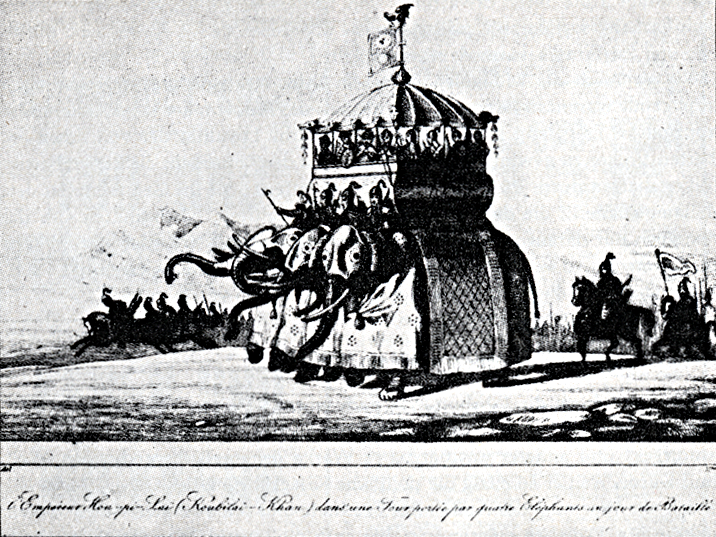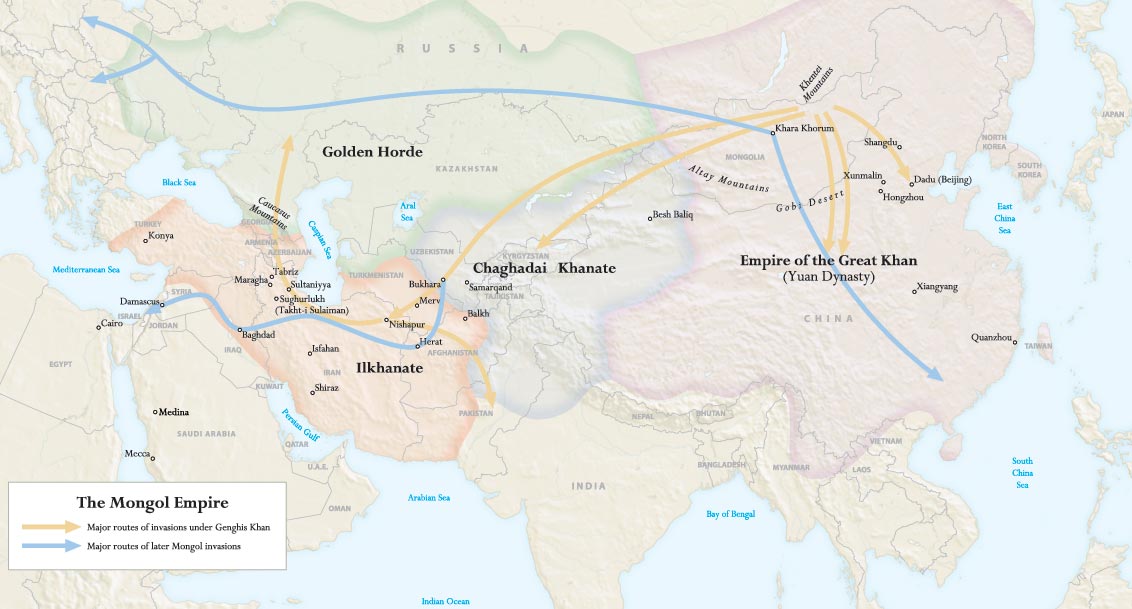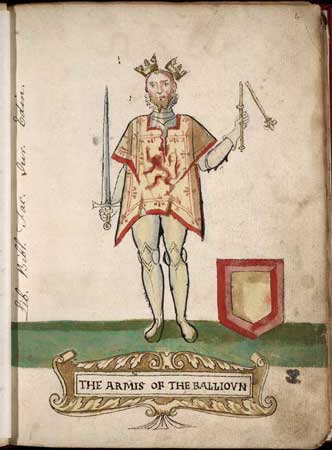|
1294
Year 1294 ( MCCXCIV) was a common year starting on Friday of the Julian calendar. Events Asia * February 18 – Kublai Khan dies; by this time the separation of the four khanates of the Mongol Empire (the Chagatai Khanate in Central Asia, the Golden Horde in Russia, the Ilkhanate in Persia, and the Yuan Dynasty in China) has deepened. Europe * March 30 – A Novgorodian army led by Prince Roman Glebovich attempts a storm of Vyborg, but the attack fails. * Spring – Following the arrival of a fleet from Sweden, an offensive takes place in which Sweden captures Kexholm after an assault. * July 5 – Following the Papal election, 1292–94, Pope Celestine V succeeds Nicholas IV, becoming the 192nd pope. * Autumn – In response to the actions of new royal administrators in north and west Wales, Madog ap Llywelyn leads a revolt against his English overlords. * December 24 – Pope Boniface VIII succeeds Pope Celestine V, becoming the 193rd pope, afte ... [...More Info...] [...Related Items...] OR: [Wikipedia] [Google] [Baidu] |
Kublai Khan
Kublai Khan (23 September 1215 – 18 February 1294), also known by his temple name as the Emperor Shizu of Yuan and his regnal name Setsen Khan, was the founder and first emperor of the Mongol-led Yuan dynasty of China. He proclaimed the dynastic name "Great Yuan" in 1271, and ruled Yuan China until his death in 1294. Kublai was the second son of Tolui by his chief wife Sorghaghtani Beki, and a grandson of Genghis Khan. He was almost 12 when Genghis Khan died in 1227. He had succeeded his older brother Möngke as Khagan in 1260, but had to defeat his younger brother Ariq Böke in the Toluid Civil War lasting until 1264. This episode marked the beginning of the division of the Mongol Empire. Kublai's real power was limited to the Yuan Empire, even though as Khagan he still influenced the Ilkhanate and, to a significantly lesser degree, the Golden Horde. In 1271, Kublai established the Yuan dynasty and formally claimed orthodox succession from prior Chinese dynasties. ... [...More Info...] [...Related Items...] OR: [Wikipedia] [Google] [Baidu] |
Pope Boniface VIII
Pope Boniface VIII (; born Benedetto Caetani; – 11 October 1303) was head of the Catholic Church and ruler of the Papal States from 24 December 1294 until his death in 1303. The Caetani, Caetani family was of baronial origin with connections to the papacy. He succeeded Pope Celestine V, who had papal resignation, abdicated from the papal throne. Boniface spent his early pontificate abroad in diplomatic roles. Boniface VIII put forward some of the strongest claims of any pope to Temporal power of the Holy See, temporal as well as spiritual power. He involved himself often with foreign affairs, including in France, Sicily, Italy, and the First War of Scottish Independence. These views, and his chronic intervention in temporal affairs, led to many bitter quarrels with Albert I of Germany, Philip IV of France, and Dante Alighieri, who expected the pope to soon arrive at the Malebolge, eighth circle of Inferno (Dante), Hell in his ''Divine Comedy'', among the simony, simoniacs. Bon ... [...More Info...] [...Related Items...] OR: [Wikipedia] [Google] [Baidu] |
Pope Celestine V
Pope Celestine V (; 1209/1210 or 1215 – 19 May 1296), born Pietro Angelerio (according to some sources ''Angelario'', ''Angelieri'', ''Angelliero'', or ''Angeleri''), also known as Pietro da Morrone, Peter of Morrone, and Peter Celestine, was head of the Catholic Church and ruler of the Papal States for five months from 5 July to 13 December 1294, when he resigned. He was also a monk and hermit who founded the order of the Celestines as a branch of the Order of Saint Benedict, Benedictine order. He was elected pope in the Catholic Church's 1292–1294 papal election, last non-conclave papal election, ending a two-year impasse. Among the few edicts of his to remain in force is the confirmation of the right of the pope to resign; nearly all of his other official acts were annulled by his successor, Pope Boniface VIII, Boniface VIII. On 13 December 1294, a week after issuing the decree, Celestine resigned, stating his desire to return to his humble, pre-papal life. He was subseque ... [...More Info...] [...Related Items...] OR: [Wikipedia] [Google] [Baidu] |
Madog Ap Llywelyn
Madog ap Llywelyn (died after 1312) was the leader of the Welsh revolt of 1294–95 against English rule in Wales. The revolt was surpassed in longevity only by the revolt of Owain Glyndŵr in the 15th century. Madog belonged to a junior branch of the House of Aberffraw and was a distant relation of Llywelyn ap Gruffudd, the last recognised native Prince of Wales. During his revolt, Madog issued a land grant in which he used the title "Prince of Wales". Lineage Madog was the son of Llywelyn ap Maredudd, the last vassal Lord of Meirionydd who had been deprived of his patrimony in 1256 for opposing the future Prince of Wales, Llywelyn ap Gruffudd, at the Battle of Bryn Derwin. Llywelyn ap Maredudd had gone into exile in England where he received a pension from the English crown, until June 1262 when he reconciled with Llywelyn ap Gruffudd. He died in a skirmish fighting for the Welsh in April 1263. His eldest son, Madog, who may have been born in exile, is known to have receiv ... [...More Info...] [...Related Items...] OR: [Wikipedia] [Google] [Baidu] |
Edward I Of England
Edward I (17/18 June 1239 – 7 July 1307), also known as Edward Longshanks and the Hammer of the Scots (Latin: Malleus Scotorum), was King of England from 1272 to 1307. Concurrently, he was Lord of Ireland, and from 1254 to 1306 ruled Duchy of Gascony, Gascony as Duke of Aquitaine in his capacity as a vassal of the French king. Before his accession to the throne, he was commonly referred to as the Lord Edward. The eldest son of Henry III of England, Henry III, Edward was involved from an early age in the political intrigues of his father's reign. In 1259, he briefly sided with a baronial reform movement, supporting the Provisions of Oxford. After reconciling with his father, he remained loyal throughout the subsequent armed conflict, known as the Second Barons' War. After the Battle of Lewes, Edward was held hostage by the rebellious barons, but escaped after a few months and defeated the baronial leader Simon de Montfort at the Battle of Evesham in 1 ... [...More Info...] [...Related Items...] OR: [Wikipedia] [Google] [Baidu] |
Mongol Empire
The Mongol Empire was the List of largest empires, largest contiguous empire in human history, history. Originating in present-day Mongolia in East Asia, the Mongol Empire at its height stretched from the Sea of Japan to parts of Eastern Europe, extending northward into parts of the Arctic; eastward and southward into parts of the Indian subcontinent, mounting invasions of Southeast Asia, and conquering the Iranian plateau; and reaching westward as far as the Levant and the Carpathian Mountains. The Mongol Empire emerged from the unification of several nomad, nomadic tribes in the Mongol heartland under the leadership of Temüjin, known by the title of Genghis Khan (–1227), whom a council proclaimed as the ruler of all Mongols in 1206. The empire grew rapidly under his rule and that of his descendants, who sent out Mongol invasions, invading armies in every direction. The vast transcontinental empire connected the Eastern world, East with the Western world, West, and the Pac ... [...More Info...] [...Related Items...] OR: [Wikipedia] [Google] [Baidu] |
Welsh Revolt Of 1294–95
During the late Middle Ages in medieval Wales, rebellions were instigated by the Welsh people in a series of battles and wars before and after the 13th century conquest of Wales by Edward I. By 1283, the whole of Wales was under the control of the Kingdom of England for the first time. Then, by 1400, after centuries of intermittent warfare in Wales, the discontent of the Welsh people with English rule in Wales culminated in the Welsh Revolt, a major uprising led by Owain Glyndŵr, who achieved de facto control over much of the country in the following years. The rebellion petered out after 1409, and after complete English control was restored in 1415, there were no further major rebellions against England in the former Kingdoms in Wales. Late Medieval Welsh rebellions Medieval kingdoms in Wales had seen rebellions as a direct consequence of the Norman invasion of Wales. By the 1080s, Wales had become fragmented, and the English kings took full advantage of the situation, launc ... [...More Info...] [...Related Items...] OR: [Wikipedia] [Google] [Baidu] |
Yuan Dynasty
The Yuan dynasty ( ; zh, c=元朝, p=Yuáncháo), officially the Great Yuan (; Mongolian language, Mongolian: , , literally 'Great Yuan State'), was a Mongol-led imperial dynasty of China and a successor state to the Mongol Empire after Division of the Mongol Empire, its division. It was established by Kublai (Emperor Shizu or Setsen Khan), the fifth khagan-emperor of the Mongol Empire from the Borjigin clan, and lasted from 1271 to 1368. In Chinese history, the Yuan dynasty followed the Song dynasty and preceded the Ming dynasty. Although Genghis Khan's enthronement as Khagan in 1206 was described in Chinese language, Chinese as the Han Chinese, Han-style title of Emperor of China, Emperor and the Mongol Empire had ruled territories including modern-day northern China for decades, it was not until 1271 that Kublai Khan officially proclaimed the dynasty in the traditional Han style, and the conquest was not complete until 1279 when the Southern Song dynasty was defeated in t ... [...More Info...] [...Related Items...] OR: [Wikipedia] [Google] [Baidu] |
Scottish Wars Of Independence
The Wars of Scottish Independence were a series of military campaigns fought between the Kingdom of Scotland and the Kingdom of England in the late 13th and 14th centuries. The First War (1296–1328) began with the English invasion of Scotland in 1296 and ended with the signing of the Treaty of Edinburgh–Northampton in 1328. The Second War (1332–1357) began with the English-supported invasion by Edward Balliol and the "Disinherited" in 1332 and ended in 1357 with the signing of the Treaty of Berwick. The wars were part of a great crisis for Scotland, and the period became one of the most defining times in its history. At the end of both wars, Scotland retained its status as an independent state. The wars were important for other reasons, such as the emergence of the longbow as a key weapon in medieval warfare. The First War of Independence: 1296–1328 Background King Alexander III of Scotland died in 1286, leaving his three-year-old granddaughter Margaret, Maid of ... [...More Info...] [...Related Items...] OR: [Wikipedia] [Google] [Baidu] |
Pope Nicholas IV
Pope Nicholas IV (; born Girolamo Masci; 30 September 1227 – 4 April 1292) was head of the Catholic Church and ruler of the Papal States from 22 February 1288 to his death, on 4 April 1292. He was the first Franciscan to be elected pope.McBrien, Richard P., ''Live of the Popes'', p.226, Harper Collins, 2000 Early life Jerome Masci (Girolamo Masci) was born on 30 September 1227 at Lisciano, near Ascoli Piceno. He was a pious, peace-loving man whose goals as a Franciscan friar were to protect the Church, promote the crusades, and root out heresy. According to Heinrich of Rebdorf, he was a Doctor of Theology. As a Franciscan friar, he had been elected the Order's superior (minister) for Dalmatia during the Franciscan general chapter held at Pisa in 1272. Pope Gregory X (1271-1276), was sending a legate to the Byzantine emperor, Michael VIII Palaiologos, in 1272, to invite the participation of Byzantine prelates in the Second Council of Lyons. The pope's ambition was to achieve ... [...More Info...] [...Related Items...] OR: [Wikipedia] [Google] [Baidu] |
Arnolfo Di Cambio
Arnolfo di Cambio ( – 1300/1310) was an Italian architect and sculptor of the Duecento, who began as a lead assistant to Nicola Pisano. He is documented as being ''capomaestro'' or Head of Works for Florence Cathedral in 1300, and designed the sixth city wall around Florence (1284–1333). By the end of his career he evidently had one or more workshops of some size, producing work with considerable stylistic variation, and distinguishing his personal hand can be difficult. Biography Arnolfo's biography is complicated by lingering uncertainties as to whether "Arnolfo di Cambio", born in Colle Val d'Elsa, Tuscany, and later Master of Works for Florence Cathedral, is the same person as "Arnolfus" who signed the Ciborium (architecture), ciboria of San Paolo fuori le Mura and Santa Cecilia in Trastevere in Rome, not to mention "Arnolfus Architectus" who signed the tomb of Pope Boniface VIII. The majority view is that they are the same man, and variations in style are caused by th ... [...More Info...] [...Related Items...] OR: [Wikipedia] [Google] [Baidu] |
Strata Florida Abbey
Strata Florida Abbey (; ) is a former Cistercian abbey situated just outside Pontrhydfendigaid, near Tregaron in the county of Ceredigion, Wales. The abbey was founded in 1164. After the region around St Davids was firmly occupied by the Normans, Norman Marcher Lord, Marcher lordship of Earl of Pembroke, Pembroke by the early 12th century, with St Davids firmly under Norman influence thereafter, the princely House of Dinefwr, Dinefwr family of Deheubarth transferred their patronage to Strata Florida, and interred many of their family members there. History Foundation The Monastery was founded in 1164 by the Cambro-Norman Knight Robert FitzStephen (c 1123–1183). In the 12th century, Cistercian monks from Whitland Abbey, Narberth, Pembrokeshire, Narberth, Carmarthenshire started to construct a religious settlement on the banks of the ''Afon Fflur'' (from which the present Abbey takes its name), a short distance from the present site. This was at a time of fast expansion of the ... [...More Info...] [...Related Items...] OR: [Wikipedia] [Google] [Baidu] |









